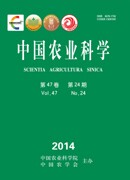【Objective】 The objective of this study is to screen the host factors interacting with coat protein (CP) of Apple chlorotic leaf spot virusthe method of bioinformatics. 【Method】 Firstly, the bait vector of pGBKT7-CP was constructed and transformed into Y2H gold. The growth of the transformed yeast was assayed on the culture plate of SD/-Trp, SD/-Trp/-His and SD/-Trp/-Ade-X-α-Gal to make clear the self-activating effect of pGBKT7-CP. The plasmids of pGBKT7-CPand pGBKT7 were transformed into Y2H gold, the OD600 of which was tested by ultraviolet spectrophotometer at different stages. The effect of pGBKT7-CP on the yeast was analyzed. Secondly, the interactive proteins of CP were screened from cDNA library of Malus sylvestristhe interaction between host and virus was deduced based on gene annotation. 【Result】 The bait vector of pGBKT7-CP was constructed. The transformed yeast Y2H gold was able to grow on the plate of SD/-Trp, but not able to grow on the plate of SD/-Trp/-His and SD/-Trp/-Ade-X-α-Gal, which implied that the recombined plasmid had no ability to activate the reporter gene of His and Ade. The growth of pGBKT7-CPand the control was similar, which predicated that the recombined plasmid had no virulence to the yeast. Sixty-nine interactive factors were obtained, which were divided into 10 types of proteins based on their functions, including transcription factor activity, carbon fixation activity, cellular iron ion homeostasis, defense response, hydrolase activity, oxidase activity, oxidoreductase activity, photosystem II assembly and protein binding activity. Eight host genes (Malus 【Conclusion】According to the results, the function of the important proteins was analyzed. It was presumed that ACLSV CP interacting with BZIP, MYB transcription factors, pathogenesis-related protein (PR-5, PR-8, PR-10), which may regulate the host resistance to virus. CP interacting with photosystem II stability/assembly factor protein and iron-binding protein may affect the stability of photosystem and the formation of chlorophyll, thereby reducing photosynthesis. This will provide a theoretical basis for revealing the mechanism of chlorotic green leaf spot and tree decline caused by ACLSV.3-1, Malus 4-2, Malus 4q1, Malus 31-3, Malus 49q2, Malus 15-1, Malus 6-2, and Malus 91-4) may play a great role in the interaction between host and virus. cv. R12740-7A constructed early by yeast two-hybrid sequencing transformation. At last, the positive clones were selected from the culture plate of SD/-Ade/-His/-Leu/-Trp/X-α-Gal and sequenced. BLAST analysis was made for the host factors in the GenBank and the function in (ACLSV) by yeast two-hybrid system and analyze their function in the interaction between host and virus by









